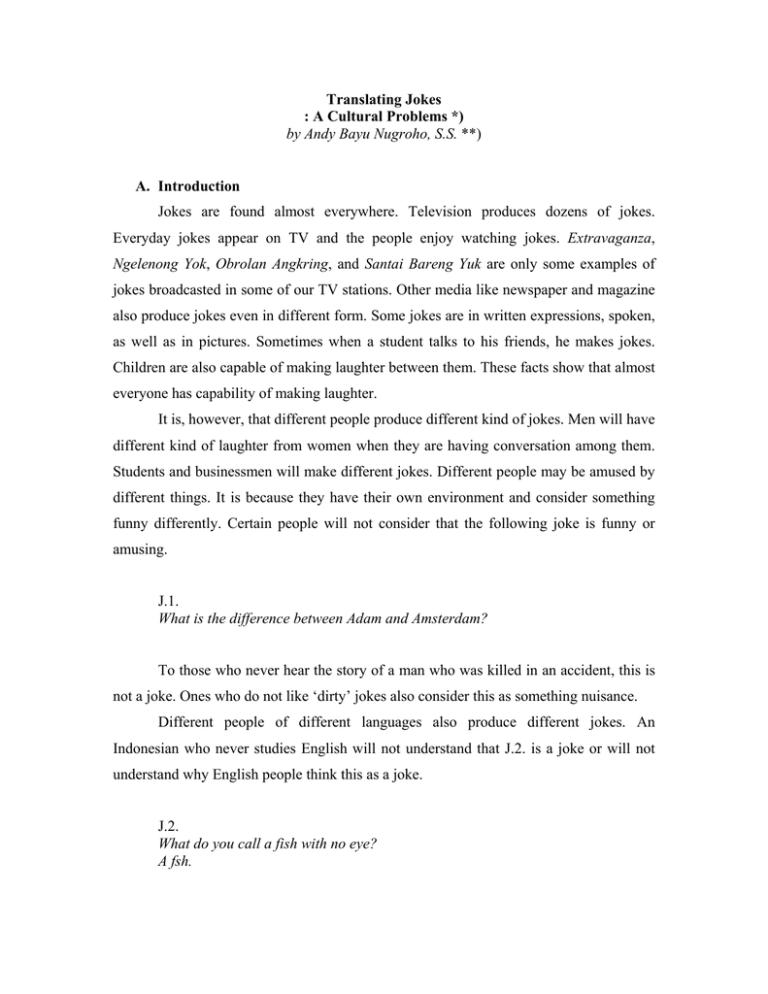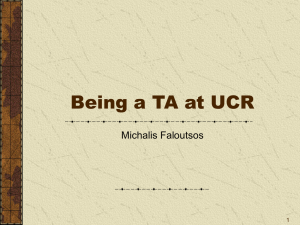Translating Jokes : A Cultural Problems *) A. Introduction
advertisement

Translating Jokes : A Cultural Problems *) by Andy Bayu Nugroho, S.S. **) A. Introduction Jokes are found almost everywhere. Television produces dozens of jokes. Everyday jokes appear on TV and the people enjoy watching jokes. Extravaganza, Ngelenong Yok, Obrolan Angkring, and Santai Bareng Yuk are only some examples of jokes broadcasted in some of our TV stations. Other media like newspaper and magazine also produce jokes even in different form. Some jokes are in written expressions, spoken, as well as in pictures. Sometimes when a student talks to his friends, he makes jokes. Children are also capable of making laughter between them. These facts show that almost everyone has capability of making laughter. It is, however, that different people produce different kind of jokes. Men will have different kind of laughter from women when they are having conversation among them. Students and businessmen will make different jokes. Different people may be amused by different things. It is because they have their own environment and consider something funny differently. Certain people will not consider that the following joke is funny or amusing. J.1. What is the difference between Adam and Amsterdam? To those who never hear the story of a man who was killed in an accident, this is not a joke. Ones who do not like ‘dirty’ jokes also consider this as something nuisance. Different people of different languages also produce different jokes. An Indonesian who never studies English will not understand that J.2. is a joke or will not understand why English people think this as a joke. J.2. What do you call a fish with no eye? A fsh. A Non native of English language will find it difficult to understand the joke because he translates ‘eye’ as a part of the body of a fish which means ‘mata’ in Indonesian. This joke shares linguistic knowledge. In written communication, it seems difficult to think why it is such kind of a joke. However, in spoken communication, the word ‘eye’ is pronounced similar to the letter ‘i’ in ‘fish’. Therefore, it is ‘what do you call a fish with no i?’ It is simply omitting ‘i’ in the word ‘fish’ to answer. Is there anything considered funny universally? Some situations are funny in almost all culture in the world. Pulling chair and slipped on a banana skin are funny situations in almost around the world. Acting extraordinarily may make other people laugh. The best example of extraordinary action is what it is seen in Mr. Bean’s scene. He does successfully make the audience get in big laughing. It seems stupid but smart. He does not think like what people like us do. Therefore, because it is strange and odd to the audience it is such a joke. In Indonesia, Warkop DKI is considered funny merely because of the characters’ foolishness. Trans TV’s Extravaganza also provides jokes by its parody. Are both funny universally? Since Warkop DKI and Extravaganza do not only provide joke through action, but also in conversation, which of course involving a certain language, the non-native of the language will not clearly understand how it can be funny for Indonesian people. Language becomes a serious opening between the actors and the audience. Probably it is not only the language which is hard to be understood. Some situations only amuse well within the border of a certain country of origin. They involve ‘culture-specific’. Although simple, non-verbal humour can be accepted in almost every country. Such situations found in situation comedy are stereotype. Someone who is getting into a mess and people’s misfortune are laughing matters. Komeng’s Spontan which was broadcasted by SCTV show those situations. Similar things are also shown at Candid Camera show. Verbal humour, in the other hand, involves linguistic components. Thomas C. Veatch, Department of Linguistics, Stanford University, stated that humor may play off of lexical ambiguity (as in puns), or make use of linguistic ill-formedness or stigmatized forms, dialect features, etc. (as in ridicule using mimicry), or may use linguistic arguments (that is, logically fallacious lines of reasoning whose apparent sense is derived from linguistic factors like ambiguity, metaphor, idioms, formal similarities) etc. Mimicry for humorous effect may make specific use of linguistic features characteristic of a dialect or of an individual's speech pattern, or may impose artificial or exaggerated intonation patterns or voice quality. Listeners who view the speech patterns of another as unusual or different may laugh at them. Grammatical errors or differences can be the focus of humorous expression. (www.tomveatch.com) There are also some universal topics of jokes. Victimizing inferior group of people might become jokes like Irishmen in England, Belgian in France, Portuguese in Brazil or a Pole in the US. Let us consider one of the advertisements on TV. When a ‘wong Tegal’, who is a ‘tukang foto kopi’ was asked by his customer, “Aslinya mana?”, he thought that the woman was asking about his original town. So, he answered “Tegal”. Why does it become funny? A non-native of Indonesian language will find that it probably is not funny. The advertisement, in fact, shows us that the inferior group, who is here the ‘wong Tegal’ is the butt of the derogatory humor. To this linguistic situation, then, bring us a question: ‘Can translation help them understanding the joke?’ B. Significance Some students of English Literature Department of Yogyakarta State University are now doing translation practicum in some publishers and TV stations in Jogja. Five students are doing the task in Andi Offset. They are asked to translate a book, 777 Great Clean Jokes. Not all jokes, of course, are easily understood. Some jokes are well understood and can be easily translated into Indonesia. Some of them are well understood but are not easily to be translated. A number of jokes are not well understood that make them impossible to translate. Surely, that these are problems for them, also for us probably. Their difficulties are sometimes found in translating jokes involving word playing, jokes involving cultural aspects, jokes which have no shared knowledge, and jokes which are actually simple but the students are not able to express them in the target language. This paper is trying to describe the main cause of their difficulties. Further more, this paper tries to solve the problems by providing some alternative of the translation. However, not all difficult jokes will be discussed here because the students have not finished all the translation. It makes the data are insufficient. This paper, then, will be followed by another research. C. Discussion 1. What is Joke Jokes do not always make the readers laugh because jokes are not always funny. Jokes are sometimes funny but sometimes they are offensive. Jokes are rich sources of paternal creativity in language use. 2. The Concept of Shared Knowledge There must be knowledge ‘behind’ a joke. Certain group of people will laugh at a joke while other group will not. The first group understands ‘what behind the joke’ while the second group does not. Things being ‘violated’ are not understood by the last group. Why don't some grown-ups laugh at such elephant jokes? It is because they don't see the point, the principles which are being violated. Consider the following elephant jokes: J.3. Q: How do you know that an elephant has been in the refrigerator? A: There are footprints in the butter dish. Or J.4. Q: How do you know that two elephants have been in the refrigerator? A: There are two sets of footprints in the butter dish. And J.5. Q: How do you know that a herd of elephants has been in the refrigerator? A: There is a Volkswagen parked in front of your house and there are lots of footprints in the butter dish. How do you find the jokes? In Bahasa Indonesia we have such similar elephant jokes like: J.6. T: Bagaimana memasukkan gajah ke dalam kulkas? J: Buka kulkasnya, masukkan gajahnya, lalu tutup pintunya. We also have the series of the joke. J.7. T: Bagaimana memasukkan Kerbau ke dalam kulkas? J: Buka kulkasnya, keluarkan gajahnya, masukkan kerbaunya, lalu tutup pintunya. This relentless, repetitive series of jokes are often not funny for many adults, but for many ten-year-olds and for some adults, elephant jokes are quite side-splitting. Children are highly involved in actively constructing their view of the structure of the world. (Veatch, www.tomveatch.com). A certain joke will ‘work’ when the readers understand ‘what behind the joke’. This will be discussed in the following point. When too culture-specific comic situations appear in front of group of people outside the culture origin, it is doubted that the situations will be found amusing. It will be related to the cultural awareness of the readers. Such jokes will successful if the play is on the knowledge which is shared between the sender and the recipient. The situation in the advertisement involving the ‘wong Tegal’ is too culture-specific. A non-native of Bahasa Indonesia, or even a non-Javanese, will hardly understand. Joke J.8. below is also culture-specific. J.8. ‘Mummy, I don’t like Daddy!’ ‘Then, leave him on the side of your plate and eat your vegetables.’ It would be seen as a joke by members of all cultures who share the same eating habits as the British. Indonesia people, who do not have the same habit, will not see J.8 as a joke because they do not understand the relationship between Daddy and vegetables. Too culture-specific situations need explanation. The shared-knowledge is not mainly (or only) in language, but also in the sociocultural aspects. The following jokes deal with both language and culture. J.9. Which Bible character had no parents? Joshua. He was the son of Nun. J.10. Charlie: Mom, tomorrow there’s a small PTA meeting. Mom: What do you mean by ‘small’? Charlie: Well, it’s just you, me, and the principal. It is also found in the Javanese joke: J.11. Becik ketitik olo rupamu In relation to the language, the recipients, then need to be able to recognize which linguistic rules is being broken / bent. It needs high standard of proficiency to be able to deal with ambiguities and hidden traps. 3. Translating Jokes It is not an easy task to translate English jokes into Indonesian. Even when the translator knows well source and target language, cultural references, and polysemous items which may be found in the jokes. Individual sounds, words, and syntax of a language reflect a separate social reality which is different from that which is reflected in another. It brings the consequence that translation is not simply a matter of substituting the words of a language with words in other language and adapting the syntax to suit it. The translator should also be able to convey the whole store of added meaning belonging to the culture of the origin language (Chiaro, 1992) Now, look at J.2, J.8 and J.9. Do you find it easy to translate them? How do will you translate them? You might simply translate J.2 into ‘Ikan apa yang tidak punya mata?’ However, the answer to the question does not sound suitable: ‘kan’. The following diagram might explain you. SL Text TL Text ‘eye’ /ai/ = part of body È ‘i’ /ai/ = the eighth letter in Æ ‘mata’ /mata/ = part of body alphabet ‘kan’ /kan/ = a suffix in Bahasa Indonesia È NO equivalent item! Jokes J.8 and J.9 will have almost the same matter. These problems are found difficult to students. Because of the limited time provided to the writer, this paper hopefully will be followed by a sufficient research after the seminar. *** *) Presented in National Seminar on Translation, 19 December 2007 at Cine Club FBS UNY **) Andy Bayu Nugroho, S.S. is a lecturer in English Language and Literature Study Program of FBS UNY




